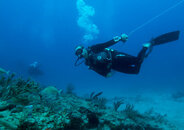And hearing about a seal team doing a 20 mile swim with force fins is not in any way meaningful to a recreational or technical diver. Go find a SEAL, put some classic Force fins on him, and I will bet $1000 he will be far behind me after a one hour swim at 60 feet deep. This is NOT about "me". This is about fins.
We are constantly barraged with "claims" from fin manufacturers about how efficient their fins are--how fast their fins are....and then as soon as I through the BS flag, someone has to start telling me that diving is not a drag race.....of course it is not. But efficiency is important, and being able to deal with sudden changes in currents ( or wind effecting a boat) is important too.
Dan
Did you ever stop to think the MOST of the Seals using ForceFins are using the classic ForceFins (Original or Pro verisons), only some of them use the TanDelta, and fewer yet using the Military SD-1. not to mention that efficiency is the ONLY reason that they select their equipment. And the US Navy Seals are allowed to use whatever fins they desire and special operations forces worldwide have selected ForceFins as their fins. Since thse SOF groups are the only diving group that I know of that makes their living by how quickly and efficently they can cover distances I believe they are uniquely qualified to determine and test the efficiency of their equipment.
The only real valid test of VO2 consumption that I know of, state
"Our recent data analysis has suggested that the cost of swimming cannot be determined from the kick frequency. This is somewhat paradoxical. If the frequency is low, the force per kick can be high; while, if the frequency, is high, the force per kick can be low. Therefore, one can observe energy requirements for any combination of kick frequency and kick force.
As far as fin selection is concerned, the differences between the fins were not remarkable underwater. It would appear that for short swims there are no differences; however, for longer swims the small differences become significant. The most economical fins were the smaller, very to moderately flexible styles. The larger, less flexible fins were the least economical. The presence of vents did not seem to be an advantage under any condition. It would appear that the smaller, more flexible fins did not compromise neither speed nor force underwater."
seems to oppose your comments, so please feel free to instruct the entire Department of Physiology of the University of Buffalo on why the methods and results they collected from 200 swimmers, novice to competitive is faulted. 200 divers, all tested in a flume tank, all with exercise monitors and CO2 production and O2 consumption monitors, and each testing 15 sets of fins. That is a very large sample set to draw conclusions from. That is not some magazines results, that is a
University based, intelletually examined, and scientifically controlled study, so even IF you manage to keep up with, or even beat me, it really doesn't mean anything, as our "playing" wouldn't even show up a a blip on the screen of the 3000+ data points that already exist.
I feel compelled to say a couple of things.
1) I do not work for ForceFin. I am a dedicated believer in the ForceFin product line, I have been asked to represent ForceFin at DEMA and am proud to be considered a friend by Bob Evans and the ForceFin family. I came to ForceFin after hearing about them and in absolute disbelief had to test them for myself.
2) I have a strong background in swimming, reaching national level competition in my day. I earned my Divemaster qualification and certified as a Navy Diver. I know what it means to push heavy loads, I know what it means to have to overcome a 3knot current, and have had to "assist" more than a few divers back into shore when the conditions went bad.
3) Does speed really matter, NO. But when you consider that each person can only perform a given amount of work (baring long term training and physical conditioning), speed is a good indicator of the efficiency, not the whole story, but a good start point when you can't easily monitor all of the variables. As that means that a diver has to work less to get the same amount of speed that they desire.
4) I will do my best to bring a Seal (in ForceFins of course) with me when I come down to take your $1000 from you. they're pretty busy guys right now (I am sure you know why) so I can't promise anything.
As for my personnal opinions- I like to believe that I base my opinions on the testing that I have observed, not from the rags, not from second hand chatter, from testing that I have done, and testing that I have been part of. I think that they are as objective as opinions can be.
For me
Paddle fins (Jets, Quattros, etc) have a purpose, I am not entirely sure what it is, but they do great control when control is critical. But there are better designs out there for recreational scuba diving.
FreeDive fins- again they have a purpose, primarily I believe they belong in their environment- Freediving. sure they can be used in scuba and other applications, but I believe, and have shown in my testing, that fins designed for scuba are generally better for scuba. My primary issue with them is that they are too cumbersome and difficult to maneuver for scuba. Especially in areas with fragile coral
Splits- I have owned and extensively used the Atomics and the Apollos and used a few others. I can't stand them, easy to kick yes, fast yes (at least in a short sprint)... but I can't maintain a kick rate of 200 kicks/min to actually make headway into a current when I need to, and I doubt many can. The Original Split fin (aka Foil Force) is the only Splits that I will ever use again, and its not even close to my favorite fin to use.
Others (Manta Ray, 6Gill, Mor-fin)- tried them, ehh. gimicks, nough said. Although there is something errily familar about the Mor-fins- they seem to be exactly the same length, width, and shape (minus the upcurved tips) of the ForceFin Originals, huh, now why would they do that?
ForceFins- well, you already know that I believe in the product line. why?? well... because they work. they work for the first time diver, first time swimmer and snorkeller, they are quickly adopted by expirienced swimmers because it matches the powerful efficient kick they have been doing since birth, for SOF because they are efficient, and for almost everyone else because they are lightwieght, packable, and nearly indestructable. They have been used in caves and deep inside of the darkest wrecks, being selected by some of the best known divers out there (John Chatterton, Jean-Micheal Cousteau, Jonathan Bird, Phil Nuytten, Hal Watts), these men can all use whatever equipment they want, but they choose ForceFins, there must be a reason for it.
Sure, we all have a bone to pick with advertising, and I think that Bob and ForceFin has an overflowing plate of ribs. Since ForceFin DOESN'T PAY for the studies that they use, they simply collect the information that others do for them. Companies like Rodales chose not to include ForceFin in their testing because they know their paying advertisers will revolt when their products are beaten. There has even been a case of a legitimate scientific study not using ForceFins because the design violated the assumptions that the study used, what was really interesting is that this study proved that the design criteria of FF is the best, but they couldn't identify a fin in the test that met the requirements for efficiency. ForceFin is simply trying to get the information that independent studies provide them with. These are not focused studies to prove FF claims, its the other way around, the studies make the claims and ForceFin distributes them.








